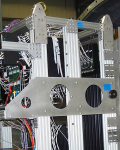Researchers from Washington University in St. Louis and the Department of Energy's Oak Ridge National Laboratory used small-angle neutron scattering to analyze the structure of chlorosomes in green photosynthetic bacteria. Chlorosomes are efficient at collecting sunlight for conversion to energy, even in low-light and extreme environments.
"It's one of the most efficient light harvesting antenna complexes found in nature," said co-author and research scientist Volker Urban of ORNL's Center for Structural Molecular Biology, or CSMB.
Neutron analysis performed at the CSMB's Bio-SANS instrument at the High Flux Isotope Reactor allowed the team to examine chlorosome structure under a range of thermal and ionic conditions.
"We found that their structure changed very little under all these conditions, which shows them to be very stable," Urban said. "This is important for potential biohybrid applications – if you wanted to use them to harvest light in synthetic materials like a hybrid solar cell, for example." Read more here.





